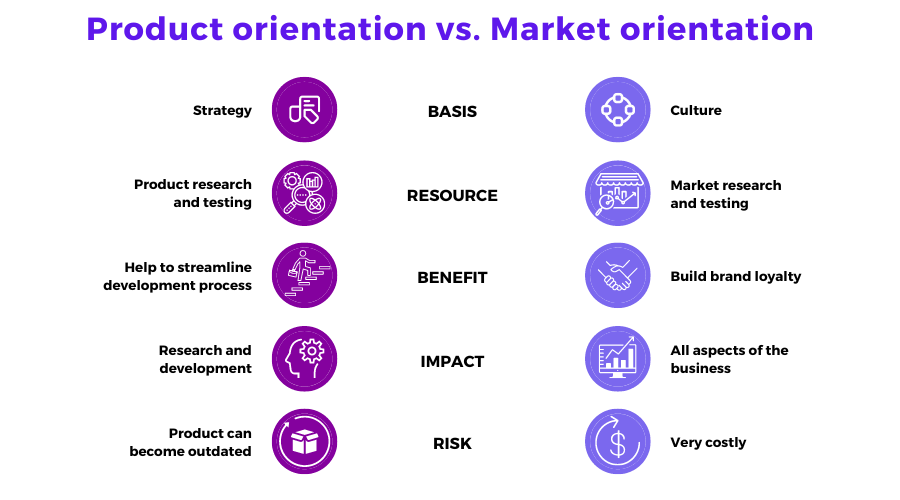What is Product Orientation?
Product orientation is a business philosophy that emphasizes the quality, features, and benefits of a product over everything else. It is a strategy that focuses on developing superior products and improving them over time, assuming that customers will be drawn to the best products available on the market.
Product orientation is a critical aspect of product management and operations. It shapes the way businesses approach product development, marketing, and sales, and it can significantly influence a company’s success or failure. This article will delve into the intricacies of product orientation, explaining its role in product management and operations, and providing practical examples and how-tos.
Product Orientation: An Overview
Product orientation is a business strategy that prioritizes the development, performance, and quality of a product above all else. It is based on the belief that customers will naturally gravitate towards the best product available, and that by focusing on creating superior products, a company can gain a competitive edge in the market.
Product orientation is often contrasted with market orientation, which emphasizes understanding and responding to customer needs and preferences. While market orientation focuses on what the customer wants, product orientation focuses on what the company believes the customer needs.
Key Elements of Product Orientation
The key elements of product orientation include a focus on product quality, continuous product improvement, and a belief in the inherent value of the product. Companies that adopt a product orientation strategy often invest heavily in research and development, and they may be less responsive to market trends and customer feedback than companies with a market orientation.
Product-oriented companies often have a strong internal focus, with a deep understanding of their own capabilities and a commitment to leveraging those capabilities to create superior products. They may be less concerned with external factors such as market trends and competitor activity, believing that the quality of their product will be enough to attract customers.
Benefits and Drawbacks of Product Orientation
Product orientation can offer several benefits. It can lead to the development of innovative, high-quality products that stand out in the market. It can also foster a culture of excellence and continuous improvement within a company, as employees strive to create the best possible products.
However, product orientation also has potential drawbacks. It can lead to a lack of responsiveness to market trends and customer feedback, which can result in missed opportunities or products that don’t meet customer needs. It can also lead to overemphasis on product features and benefits at the expense of other important factors, such as price and customer service.
Role of Product Orientation in Product Management
In product management, product orientation shapes the way products are developed, marketed, and sold. It influences the decisions made at every stage of the product lifecycle, from initial concept to final sale.
Product managers in product-oriented companies often have a strong technical background, as they need to understand the intricacies of the product in order to make informed decisions about its development. They may also need to be skilled at communicating the value of the product to other stakeholders, such as sales teams and customers.
Product Development
In a product-oriented company, product development is often driven by a desire to create the best possible product, rather than by market research or customer feedback. This can lead to innovative, high-quality products, but it can also result in products that don’t meet customer needs or expectations.
Product development in a product-oriented company often involves a high level of technical expertise. Developers may need to be skilled in the latest technologies and techniques, and they may need to be willing to take risks and push boundaries in order to create a superior product.
Product Marketing
Product marketing in a product-oriented company often focuses on highlighting the features and benefits of the product. The goal is to convince customers that the product is the best on the market, and that its superior quality and performance justify its price.
Product marketing in a product-oriented company may involve a high level of technical detail, as marketers need to be able to explain the intricacies of the product to potential customers. This can be a challenge, as it requires a balance between technical accuracy and accessibility for non-technical customers.
Role of Product Orientation in Operations
In operations, product orientation influences the way products are produced, distributed, and serviced. It shapes the decisions made at every stage of the operational process, from sourcing materials to delivering the final product to the customer.
Operations managers in product-oriented companies often need to have a deep understanding of the product and its production process. They may need to be skilled at managing complex, high-tech production systems, and they may need to be committed to continuous improvement in order to maintain the quality of the product.
Product Production
Product production in a product-oriented company is often driven by a desire to create the highest quality product possible. This can involve a high level of attention to detail, rigorous quality control processes, and a willingness to invest in the best materials and technologies.
Product production in a product-oriented company can also involve a high level of complexity, as the desire for superior quality can lead to complex production processes. Operations managers may need to be skilled at managing these complexities, and they may need to be committed to continuous improvement in order to maintain the quality of the product.
Product Distribution and Service
Product distribution and service in a product-oriented company often focus on ensuring that the product reaches the customer in the best possible condition. This can involve careful packaging, reliable delivery systems, and high-quality customer service.
Product distribution and service in a product-oriented company can also involve a high level of attention to detail, as the desire for superior quality can extend to every aspect of the customer experience. Operations managers may need to be skilled at managing these details, and they may need to be committed to continuous improvement in order to maintain the quality of the customer experience.
Examples of Product Orientation
Many successful companies have adopted a product orientation strategy. For example, Apple is often cited as a product-oriented company. They focus on creating innovative, high-quality products, and they often lead the market in terms of technology and design.
Another example is Tesla, which focuses on creating the best electric cars in the world. They invest heavily in research and development, and they often push the boundaries of what is possible in terms of technology and performance.
Apple’s Product Orientation
Apple’s product orientation is evident in its commitment to creating innovative, high-quality products. They invest heavily in research and development, and they often lead the market in terms of technology and design. Their products, such as the iPhone and the MacBook, are known for their superior quality and performance.
Apple’s product orientation is also evident in its marketing. They often highlight the features and benefits of their products, and they use high-quality materials and design to create a premium brand image. They also price their products at a premium, reflecting their belief in the inherent value of their products.
Tesla’s Product Orientation
Tesla’s product orientation is evident in its commitment to creating the best electric cars in the world. They invest heavily in research and development, and they often push the boundaries of what is possible in terms of technology and performance. Their cars, such as the Model S and the Model X, are known for their superior quality and performance.
Tesla’s product orientation is also evident in its marketing. They often highlight the features and benefits of their cars, and they use high-quality materials and design to create a premium brand image. They also price their cars at a premium, reflecting their belief in the inherent value of their products.
How to Implement a Product Orientation Strategy
Implementing a product orientation strategy involves a shift in focus from the market to the product. It requires a commitment to creating the best possible product, and a belief in the inherent value of that product. It also requires a willingness to invest in research and development, and a commitment to continuous improvement.
Implementing a product orientation strategy also involves a shift in marketing and sales strategies. Instead of focusing on market trends and customer preferences, the focus is on highlighting the features and benefits of the product. This can involve a high level of technical detail, and it requires a balance between technical accuracy and accessibility for non-technical customers.
Developing a Product-Oriented Culture
Developing a product-oriented culture involves fostering a culture of excellence and continuous improvement. It involves encouraging employees to strive for the best in everything they do, and to take pride in the quality of their work. It also involves providing the resources and support necessary for employees to develop their skills and knowledge.
Developing a product-oriented culture also involves creating a shared vision and goals. This involves communicating the company’s commitment to product quality and continuous improvement, and aligning the company’s goals and strategies with this commitment. It also involves recognizing and rewarding employees who contribute to the achievement of these goals.
Investing in Research and Development
Investing in research and development is a key part of implementing a product orientation strategy. It involves dedicating resources to exploring new technologies and techniques, and to developing innovative, high-quality products. It also involves creating a culture of innovation, where employees are encouraged to experiment and take risks.
Investing in research and development also involves staying abreast of the latest trends and developments in the industry. This involves keeping up with the latest research and developments, and incorporating this knowledge into the product development process. It also involves fostering relationships with industry experts and thought leaders, and leveraging their knowledge and expertise.
Marketing and Selling the Product
Marketing and selling the product in a product-oriented company involves highlighting the features and benefits of the product. It involves communicating the value of the product to customers, and convincing them that the product is the best on the market. It also involves pricing the product at a premium, reflecting the company’s belief in the inherent value of the product.
Marketing and selling the product in a product-oriented company also involves providing high-quality customer service. This involves ensuring that customers have a positive experience with the product, from the moment they first hear about it to the moment they make a purchase. It also involves providing ongoing support and service, to ensure that customers continue to be satisfied with the product.
Businesses tend to develop new products based on either a marketing orientated approach or a product orientated approach.
A marketing orientated approach means a business reacts to what customers want. The decisions taken are based around information about customers’ needs and wants, rather than what the business thinks is right for the customer. Most successful businesses take a market-orientated approach.
A product orientated approach means the business develops products based on what it is good at making or doing, rather than what a customer wants. This approach is usually criticised because it often leads to unsuccessful products – particularly in well-established markets.
Most markets are moving towards a more market-orientated approach because customers have become more knowledgeable and require more variety and better quality. To compete, businesses need to be more sensitive to their customers needs otherwise they will lose sales to their rivals.
On the other hand some products are argued to create a need or want in the customer, especially products with a very high technological content. Mobile phones have moved a long way from being a niche business accessory to being an essential consumer item incorporating a wide range of applications.
Innovations create the need rather than the customer being able to second-guess how new technology is going to develop.

Product Orientation vs. Market Orientation
Now that we know what it is, let’s look at market orientation and how it differs from product orientation.
This is a business culture that prioritizes client happiness.
The company guarantees that its values, norms, conduct, and the established processes, structures, and control inside the organization are by the customers’ needs.
So the reaction is based on what the consumer wants.
The attention shifted to the market and the clients’ needs within each market group soon.
Customers began to prefer customized products over time, and this orientation met that need.
Customers’ demands and desires became the focal point of whatever a firm tried to achieve, resulting in high-quality, personalized products that set them apart from their competition.
The focus of market orientation:
- What clients want.
- Developing and maintaining customer relationships.
- Keeping track of data for evaluation and study.
- Creating a link between client needs and organizational capabilities.
Many companies are interested in individuals who can speak to and persuade clients while also generating profit for the company. Product and market orientations are the talents individuals acquire to maintain a company’s profitability.
So you can see why both of these factors are crucial!
The difference:
While product orientation focuses entirely on the product’s quality, market orientation concentrates on the wants and satisfaction of customers.
Production orientation began in the middle of the 1950s, when items were in a limited stage of development, whereas Market orientation began around 1990 when businesses needed to make money.
Product research, product testing, and product focus are methods utilized in product orientation. Market research, market testing, and customer focus, on the other hand, are techniques used in market orientation.

Chisel provides a quick and easy way to conduct product feedback surveys. The pre-built survey templates from our library can be customized to suit your needs.
You can survey an audience you already have or survey a precise customer segment of your choosing via our audience panel.
Product orientation is a culture of product quality and rate setting, whereas market orientation is a business culture.
Using the product orientation strategy, a company attempts to create high-quality items that appeal to customers. An organization that uses the market orientation approach, on the other hand, attempts to understand customers’ demands and respond to them in the best possible way, therefore satisfying customers.
Product Orientation is in companies such as Gillette, Coco-Cola, Travis Perkins, and many others. Companies such as Amazon, Starbucks Coffee, Singapore Airlines, and many others fall into the market orientation category.
There is no “correct” method to run a company. Every day, business leaders suffer from a slew of critical decisions, and how they make these decisions can significantly impact strategic development, business perspective, and, ultimately, sales.
While a firm can use various marketing methods, they must align with the company and product goals, structure, and capabilities. Business people can pick between market orientation, product orientation, and sales orientation with the support of business strategists.

Why Is Product Orientation Important?
Product Orientation refers to a company’s emphasis on a single product, ensuring the achievement of the highest quality and performance.
The company splurges a lot of money on product development and research to ensure that the product sells itself, and they feel that as long as the product is of excellent quality, people will buy it.
By its very nature, continuous innovation allows a company to be the first to market in a new industry and, more crucially, to keep that edge.
Furthermore, organizations that consistently demonstrate their innovation ability tend to have a difficult-to-replicate brand following.
What Are the Advantages and Disadvantages of Product Orientation?
When sales drop, companies with this focus respond by increasing output and lowering prices. In cases where consumer demand exceeds supply, this attitude is highly effective.
After thoroughly analyzing and connecting with its target customers, it seeks to boost sales by providing clients with what they believe they require.
A few advantages are as follows:
- It enables a corporation to devote all its attention to a single product, ensuring that only the highest quality is delivered.
- Companies utilize economies of scale to achieve optimum efficiency at the lowest possible cost.
- Customers can tell you how to make your product through focus groups, questionnaires, polls, and other market research.
- Because a corporation focuses solely on one product, the manufacturing process is more straightforward.
- Customers benefit from low prices.
- Salespeople are an essential part of the product development process of a product-oriented organization. You don’t hire salespeople after you’ve decided to add a new product or change an existing one. You bring them in to find out what customers are saying, what objections lead to rejections, and other information about your and your competitors’ products.
A Product Orientation is one of the orientations in which businesses first concentrate solely on product quality. In a nutshell, companies produce high-quality goods at a specific price.
A few disadvantages are as follows:
- A great product does not always imply a good profit margin. A company may phase out if a competitor with the same product concentrates on consumer demands.
- Customers may or may not be fascinated by what you have to offer.
- Product obsolescence caused by technological changes and other market variables can lead to a company’s demise.
- Customers may not trust you to provide the items if you don’t have a solid reputation.
- A corporation that takes this approach will miss out on many market prospects.
- An ace product’s R&D costs could be high.
- To profit from a high-quality product, you may need to charge a more excellent price than the market would bear.
What Are Product Orientation Examples?
Many businesses utilize a combination of market and product orientation, with some emphasizing the latter.
These businesses are usually innovators who come out of nowhere with hot new products that consumers didn’t even know they wanted.
Are you curious as to which these companies are? Follow along to know more.
- The Gillette Company focuses on making the best disposable, eco-friendly razors at a minimal price. As a result, they set themselves separate with high-quality razor blades, ease of use, and an appropriate pricing plan.
- No one had fully imagined the iPod, iPhone, iPad — iAnything — before Steve Jobs and the Apple team rose to the level of tech fame that the business has today. Jobs and his team could profit from these and other revolutionary new items by delivering things they correctly projected would be in high demand.
- Another great example is Henry Ford’s Ford Motor Company, which produced only black-colored automobiles regardless of public preferences.





